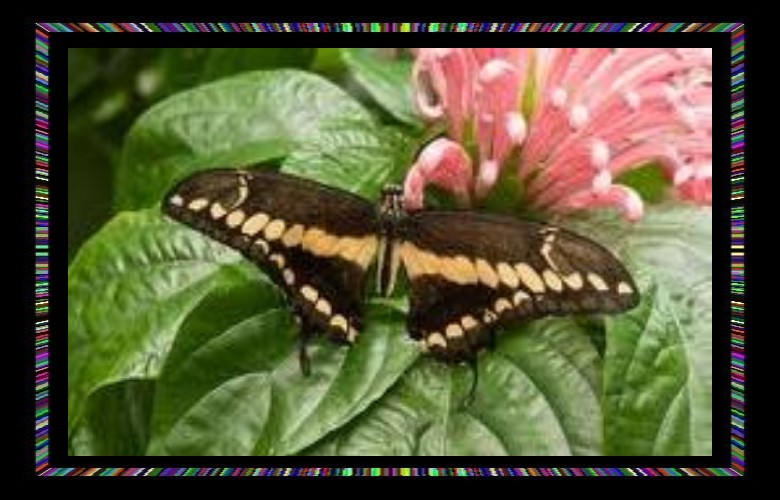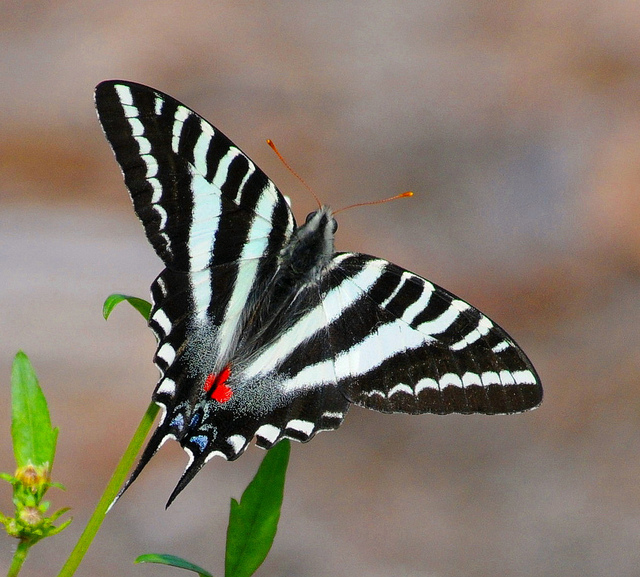

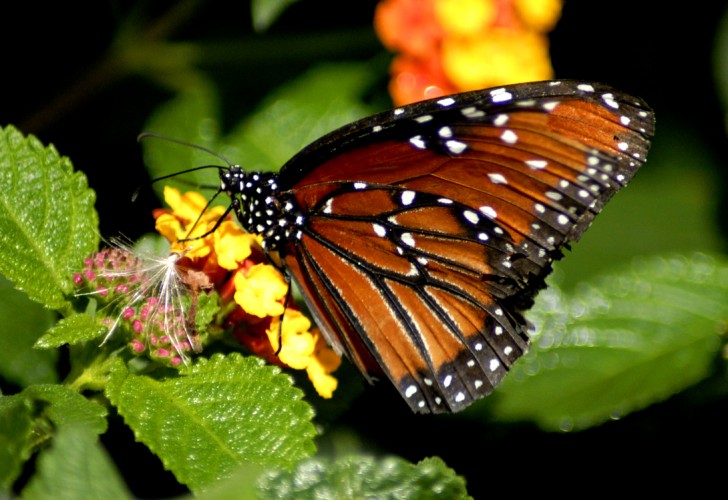
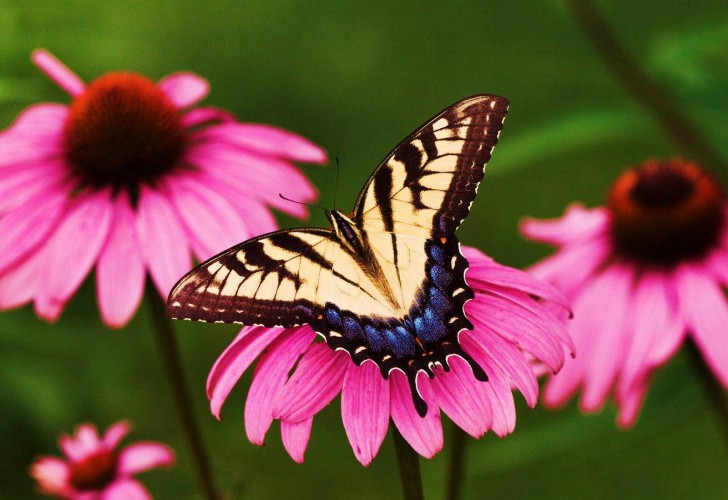




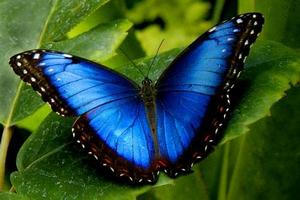
Flutter
The Gospel of the Spring.
“ The Hope of Glory"
Here is something else that flits among the flowers, and feeds on their honey, as well as the bees that we talked about last week. The butterflies-how pretty they look as they soar in the air like tiny birds, or rest for a moment to sip the honey from the flowers, looking almost like their own bright petals. In fact, when their wings are closed, the butterflies can sometimes scarcely be distinguished from the leaves of the plants on which they settle.
But while you watch them and admire their beauty, do you ever think of their wonderful life story? They were not always as you see them now, but in their short lives they have passed through marvelous changes, before they became the perfect and beautiful butterflies that you see.
If you should keep some of the tiny eggs that the butterfly lays, and watch them, would you see little baby butterflies with tiny wings come from them, expecting to be fed with honey? No; little insects not at all like their mother,-little grubs or caterpillars,-would crawl out, eat up the shell of the egg, and begin at once to feed greedily upon the leaf where the eggs had been laid. For although the butterfly herself feeds only on honey, and knows nothing about caterpillars and their food, she always lays her eggs in just the place where the little caterpillars will find the very food that they want.
This is very wonderful, for different kinds of caterpillars feed on different plants, some on cabbage leaves, some on the leaves of the nettle, and some on other plants. But the mother never makes a mistake; she always leaves the eggs where the young ones will find the right kind of food ready for them. See how carefully and lovingly she provides for the young ones whom she will never see; for almost as soon as the eggs are laid, the butterfly dies.
How can she have such wisdom and intelligence, you will perhaps wonder. But this wisdom belongs not to the butterfly, it belongs to the life that she has, which is not her own, but God's life in her, as it is in all His works, guiding each one in the right way. It is the life, which holds the earth in its place and guides it in its path round the sun, that guides it in its path round the sun, that guides each tiny insect in just the works that God has appointed for it.
We have been learning about the plants that they are not perfect at once, but come forth, "first the blade, then the ear, after that the full corn in the ear." And it is just the same with these little insects; there is first the grub or caterpillar, then the chrysalis, and at last the perfect creature,-the butterfly.
The caterpillar is a very hungry little thing, and spends nearly all its life feeding, for it needs a great deal of food to enable it to do the work for which it is getting ready. It grows very fast, and when its coat gets too small, it casts it off and appears in a new and larger one that has been growing underneath.
After living in this way for some weeks or months, the caterpillar builds or spins a little house for itself like a tiny coffin, and wrapping its body in a beautiful silken shroud that it spins for this purpose, it passes into the state of rest called the chrysalis state, in which it eats nothing at all, and shows no sign of life. Some even bury themselves under the ground, but others fasten their little houses to the leaves or twigs of plants.
Those that pass into the chrysalis state in the autumn, stay in this condition all the winter. But when the warm sunshine comes back again, the time of their rest and burial is over, the little prison houses burst open, and out come,-not the old creeping caterpillars, but beautiful soaring butterflies, with large painted wings covered with delicate feathery scales, able to soar like the birds, and as beautiful as the flowers.
What a change! What a wonderful transformation! Think, then, of the glorious possibilities wrapped up in each little creeping caterpillar that you see. When its short life of toil is over, it passes from sight, and there seems to be an end of it. But is it so? Oh, no; when its appointed times comes, it awakes clothed with a more beautiful garment, with new powers, to a new and fuller life.
Is not this a wonderful chapter of the Gospel of the Spring?-the Gospel of Hope, "the hope of glory," we may call it: for this is the message of the Spring season, and through all the ages it has been teaching the same beautiful lesson.
The patriarch Job, who lived 4,000 years ago, asked, "If a man die shall he live again?" and then he answered his own question by saying, "All the days of my appointed time will I wait, till my change come." He had seen the seeds that were buried in the ground spring up at the appointed time in freshness and beauty; he had seen the caterpillar passing away into the chrysalis, waiting all the days of its appointed time till its wonderful change should come. The spring flowers, and the butterflies that flit among them, are teaching us the same beautiful lesson that Job had learned, a lesson of life and hope.
But there is one thing that I want you to notice particularly: This change, the bursting forth of the perfect insect, which seems so sudden, is really only the end of a work that has been going on for a long time, in fact ever since the little caterpillar was born the butterfly has been gradually forming within it. But now it comes forth so that the hidden and wonderful work that has been going on can be clearly seen.
All this is to teach us something of the wonderful "mystery of the Gospel." The Apostle Paul when he speaks of this mystery, tells us what it is; he says that it is "Christ in you, the hope of glory."
"The hope of glory" for the caterpillar is the beautiful butterfly forming within it, which by and by will transform within it, which by and by will transform and change its whole body. "The hope of glory" for us is "Christ formed within us,"-the power of His life working in us now to take away our old sinful nature, and change us into His image.
And by and by it will be clearly seen who are those in whom this change has been going on, for when Jesus comes there will be "a manifestation (a revealing, or showing forth) of the sons of God." Then their whole bodies will be changed, and "fashioned like unto His glorious body."
As you see the caterpillar crawling on the ground and on the plants, think, dear children, of the wonders going on in its tiny frame, and ask Jesus, who is doing this work, to work in you also by His power, and change you into His image, so that you may be among those who "shall be like Him," when "they shall see Him as He is?"
March 9, 1899 EJW, PTUK 155
"Better than a Fairy Tale"
A gentleman living in St. Fernando, Chili, about twenty years ago, was charged with witchcraft, and arrested by the authorities, because he had some caterpillars that turned into butterflies!
You will, no doubt, be astonished to hear of such ignorance, for almost every child now knows that caterpillars turn into butterflies.
And yet to one who does not know and consider the wonderful works of God, this transformation seems so strange, and so like a romance or fairy story, that it is no wonder that they were at a lose to account for it.
Goethe said: "I would call these transmutations wonderful, if the wonderful in nature were not that which occurs every moment."
The works of God that are going all around us are much more wonderful than any of the fairy stories that people make up out of their own minds, and much more beautiful too, because they are all true.
Is it not then, dear children, much better for us to "consider the wondrous works of God," and so get our minds filled with truth and beauty, than to waste our time filling our minds with the lies that people spin out of their own imagination?
"I love to tell the story,
More wonderful it seems
Than all the golden fancies
Of all our golden dreams."
March 9, 1899 EJW, PTUK 155

